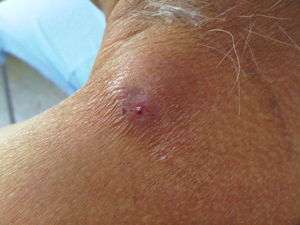Myiasis
Background

Myiasis in patient neck
- Caused by Diptera species. Dermatobia hominis (botfly) is most common cause in North America
- Cutaneous (includes follicular, wound, and migratory) type is most common
- Can also occur in mouth, urogenital, ophthalmic, nasopharyngeal location
- Typically occurs in tropical and subtropical areas. US cases typically due to travel to endemic region[1]
- Bacterial superinfection is rare[2]
Clinical Features
- Erythematous papule with central pore (allows for larval respiration)[2]
- Sensation of movement within lesion
- Serous drainage
Differential Diagnosis
Travel-related skin conditions
Papules
- Insect bites
- Scabies
- Seabather's eruption
- Cercarial dermatitis (Swimmer's Itch)
Sub Q Swelling and Nodules
Ulcers
Linear and Migratory Lesions
- Cutaneous larvae migrans
- Photodermatitis
See also domestic U.S. ectoparasites
Domestic U.S. Ectoparasites
- Bed bugs
- Lice
- Scabies (Mites)
- Ticks
- Fleas
- Pseudoparasites
- Delusional parasitosis (Ekbom syndrome)
See also travel-related skin conditions
Evaluation
- Clinical diagnosis
Management[2]
If entire larvae is not removed, severe inflammatory response occurs
- Occlusion of central pore with petroleum jelly or mineral oil interrupts oxygen supply and causes larvae to migrate to surface where it can be grasped with forceps and removed
- Can take up to 24 hours
- Manual removal by squeezing out larvae
- Surgical removal by making incision over larvae and removing with forceps
- Ivermectin - single PO dose or topical application
- Wound myiasis requires surgical debridement
- Ocular, nasopharyngeal, urogenital myiasis should prompt appropriate specialist consultation for management
Disposition
- Cutaneous myiasis generally may be discharged after removal
- Disposition of other forms based on discussion with specialist
See Also
- Parasitic Diseases
- Travel Medicine
External Links
References
- https://www.cdc.gov/parasites/myiasis/faqs.html Accessed 02/06/17
- McGraw TA. Turiansky GW. Cutaneous myiasis. Journal of the American Academy of Dermatology. 58(6):907-26; quiz 927-9, 2008 Jun.
This article is issued from
Wikem.
The text is licensed under Creative
Commons - Attribution - Sharealike.
Additional terms may apply for the media files.